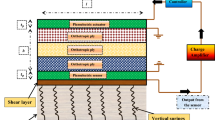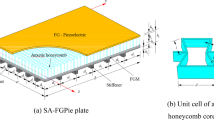Abstract
An analytical solution has been developed developed in this research for electro-mechanical flexural response of smart laminated piezoelectric composite rectangular plates encompassing flexible-spring boundary conditions at two opposite edges. Flexible-spring boundary structure is introduced to the system by inclusion of rotational springs of adjustable stiffness which can vary depending on changes in the rotational fixity factor of the springs. To add to the case study complexity, the two other edges are kept free. Three advantages of employing the proposed analytical method include: (1) the electro-mechanical flexural coupling between the piezoelectric actuators and the plate’s rotational springs of adjustable stiffness is addressed; (2) there is no need for trial deformation and characteristic function—therefore, it has higher accuracy than conventional semi-inverse methods; (3) there is no restriction imposed to the position, type, and number of applied loads. The Linear Theory of Piezoelectricity and Classical Plate Theory are adopted to derive the exact elasticity equation. The higher-order Fourier integral and higher-order unit step function differential equations are combined to derive the analytical equations. The analytical results are validated against those obtained from Abaqus Finite Element (FE) package. The results comparison showed good agreement. The proposed smart plates can potentially be applied to real-life structural systems such as smart floors and bridges and the proposed analytical solution can be used to analyze the flexural deformation response.















Similar content being viewed by others
References
Liew KM, Pan ZZ, Zhang LW. An overview of layerwise theories for composite laminates and structures: development, numerical implementation and application. Compos Struct. 2019;216(January):240–59.
Khosravani MR, Anders D, Weinberg K. Influence of strain rate on fracture behavior of sandwich composite T-joints. Eur J Mech A/Solids. 2019;78:103821.
Zhang M, Sun B, Gu B. Meso-structure ageing mechanism of 3-D braided composite’s compressive behaviors under accelerated thermo-oxidative ageing environment. Mech Mater. 2017;115:47–63.
Coda HB. Continuous inter-laminar stresses for regular and inverse geometrically non linear dynamic and static analyses of laminated plates and shells. Compos Struct. 2015;132:406–22.
De Faria AR, Oguamanam DCD, Donadon MV. Prebuckling enhancement of imperfect composite plates using piezoelectric actuators. J Appl Mech Trans ASME. 2011;78(3):1–8.
Ozdemir O, Kaya MO. Energy derivation and extension-flapwise bending vibration analysis of a rotating piezolaminated composite timoshenko beam. Mech Adv Mater Struct. 2014;21(6):477–89.
Maleki VA, Mohammadi N. Buckling analysis of cracked functionally graded material column with piezoelectric patches. Smart Mater Struct. 2017;26(3):035031.
Zhang S, Xu L. Analytical solutions for flexure of rectangular orthotropic plates with opposite rotationally restrained and free edges. Arch Civ Mech Eng. 2018;18(3):965–72.
Xu L, Tangorra FM. Experimental investigation of lightweight residential floors supported by cold-formed steel C-shape joists. J Constr Steel Res. 2007;63(3):422–35.
Bhaskar K, Sivaram A. Untruncated infinite series superposition method for accurate flexural analysis of isotropic/orthotropic rectangular plates with arbitrary edge conditions. Compos Struct. 2008;83(1):83–92.
Liu Y, Li R. Accurate bending analysis of rectangular plates with two adjacent edges free and the others clamped or simply supported based on new symplectic approach. Appl Math Model. 2010;34(4):856–65.
Bhaskar K, Kaushik B. Simple and exact series solutions for flexure of orthotropic rectangular plates with any combination of clamped and simply supported edges. Compos Struct. 2004;63(1):63–8.
Lim CW, Cui S, Yao WA. On new symplectic elasticity approach for exact bending solutions of rectangular thin plates with two opposite sides simply supported. Int J Solids Struct. 2007;44(16):5396–411.
Li R, Zhong Y. On a new symplectic geometry method for exact bending solutions of orthotropic rectangular plates with two opposite sides clamped. Acta Mech. 2011;216(1–4):333–43.
Shi W, Li XF, Wang CY. Bending of a rectangular plate with rotationally restrained edges under a concentrated force. Appl Math Comput. 2016;286:265–78.
Zhang S, Xu L. Bending of rectangular orthotropic thin plates with rotationally restrained edges: a finite integral transform solution. Appl Math Model. 2017;46:48–62.
Li R, Zhong Y, Tian B, Liu Y. On the finite integral transform method for exact bending solutions of fully clamped orthotropic rectangular thin plates. Appl Math Lett. 2009;22(12):1821–7.
Li R, Tian B, Zhong Y. Analytical bending solutions of free orthotropic rectangular thin plates under arbitrary loading. Meccanica. 2013;48(10):2497–510.
An C, Gu J, Su J. Exact solution of bending problem of clamped orthotropic rectangular thin plates. J Brazilian Soc Mech Sci Eng. 2016;38(2):601–7.
Gohari S, Sharifi S, Vrcelj Z. New explicit solution for static shape control of smart laminated cantilever piezo-composite-hybrid plates/beams under thermo-electro-mechanical loads using piezoelectric actuators. Compos Struct. 2016;145:89–112.
Gohari S, Sharifi S, Vrcelj Z. A novel explicit solution for twisting control of smart laminated cantilever composite plates/beams using inclined piezoelectric actuators. Compos Struct. 2017;161:477–504.
Cornacchia F, Fantuzzi N, Luciano R, Penna R. Solution for cross- and angle-ply laminated Kirchhoff nano plates in bending using strain gradient theory. Compos Part B Eng. 2019;173:107006.
Bohlooly M, Mirzavand B. Closed form solutions for buckling and postbuckling analysis of imperfect laminated composite plates with piezoelectric actuators. Compos Part B Eng. 2015;72:21–9.
Reddy JN. On laminated composite plates with integrated sensors and actuators. Eng Struct. 1999;21(7):568–93.
Yang KJ, Lee KY, Chang JH. Elastic analysis for defects in an orthotropic kirchhoff plate. J Appl Mech Trans ASME. 2007;74(3):438–46.
Kharghani N, Guedes Soares C. Behaviour of composite laminates with embedded delaminations. Compos Struct. 2016;150:226–39.
Shao D, Hu F, Wang Q, Pang F, Hu S. Transient response analysis of cross-ply composite laminated rectangular plates with general boundary restraints by the method of reverberation ray matrix. Compos Struct. 2016;152:168–82.
Moghadam PY, Tahani M, Naserian-Nik AM. Analytical solution of piezolaminated rectangular plates with arbitrary clamped/simply-supported boundary conditions under thermo-electro-mechanical loadings. Appl Math Model. 2013;37(5):3228–41.
Her SC, Lin CS. Deflection of cross-ply composite laminates induced by piezoelectric actuators. Sensors. 2010;10(1):719–33.
Serov V. Fourier series, Fourier transform and their applications to mathematical physics, vol. 197. Cham: Springer International Publishing; 2017.
Hoskins RF. Delta functions: introduction to generalised functions. 2nd ed. Cambridge: Woodhead Publishing; 2009.
Green AE. Double Fourier series and boundary value problems. Math Proc Cambridge Philos Soc. 1944;40(3):222–8.
The Mathworks Inc., Matlab R2019a [computer program]. 2019.
Duc ND, Quan TQ, Luat VD. Nonlinear dynamic analysis and vibration of shear deformable piezoelectric FGM double curved shallow shells under damping-thermo-electro-mechanical loads. Compos Struct. 2015;125:29–40.
Yu Y, Zhang XN, Xie SL. Optimal shape control of a beam using piezoelectric actuators with low control voltage. Smart Mater Struct. 2009;18(9):1–15.
Abaqus, Dassault Systemes, Abaqus FEA software. 2018.
Lammering R, Mesecke-Rischmann S. Multi-field variational formulations and related finite elements for piezoelectric shells. Smart Mater Struct. 2003;12(6):904–13.
Carrera E, Boscolo M, Robaldo A. Hierarchic multilayered plate elements for coupled multifield problems of piezoelectric adaptive structures: formulation and numerical assessment. Arch Comput Methods Eng. 2007;14(4):383–430.
Zboiński G. Problems of hierarchical modelling and hp-adaptive finite element analysis in elasticity, dielectricity and piezoelectricity. In: perusal of the finite element method, InTech; 2016. p. 1–29.
Zboiński G. Adaptive modeling and simulation of elastic, dielectric and piezoelectric problems. In: Finite element method—simulation, numerical analysis and solution techniques. InTech; 2018. p. 157–92.
Mouloodi S, Rahmanpanah H, Burvill C, Davies HM. Prediction of displacement in the equine third metacarpal bone using a neural network prediction algorithm. Biocybern Biomed Eng. 2020;40(2):849–63.
Mouloodi S, Rahmanpanah H, Burvill C, Davies HMS. Prediction of load in a long bone using an artificial neural network prediction algorithm. J Mech Behav Biomed Mater. 2020;102:103527.
Rahmanpanah H, Mouloodi S, Burvill C, Gohari S, Davies HMS. Prediction of load-displacement curve in a complex structure using artificial neural networks: a study on a long bone. Int J Eng Sci. 2020;154:103319.
Faroughi S, Shafei E, Eriksson A. NURBS-based modeling of laminated composite beams with isogeometric displacement-only theory. Compos Part B Eng. 2019;162:89–102.
Le Thanh C, Tran LV, Vu-Huu T, Abdel-Wahab M. The size-dependent thermal bending and buckling analyses of composite laminate microplate based on new modified couple stress theory and isogeometric analysis. Comput Methods Appl Mech Eng. 2019;350:337–61.
Gohari S, Sharifi S, Vrcelj Z, Yahya MY. First-ply failure prediction of an unsymmetrical laminated ellipsoidal woven GFRP composite shell with incorporated surface-bounded sensors and internally pressurized. Compos Part B Eng. 2015;77:502–18.
Gohari S, Sharifi S, Abadi R, Izadifar M, Burvill C, Vrcelj Z. A quadratic piezoelectric multi-layer shell element for FE analysis of smart laminated composite plates induced by MFC actuators. Smart Mater Struct. 2018;27(9):095004.
Kress G, Winkler M. Corrugated laminate homogenization model. Compos Struct. 2010;92(3):795–810.
Author information
Authors and Affiliations
Corresponding author
Ethics declarations
Conflict of interest
The authors declare that there is not conflict of interest between the authors.
Ethical approval
This article does not contain any studies with human participants or animals performed by any of the authors.
Additional information
Publisher's Note
Springer Nature remains neutral with regard to jurisdictional claims in published maps and institutional affiliations.
Appendices
Appendices
1.1 Appendix A
The relation between the global and local stresses in a composite layer is stated in Eq. 32. The transformation matrix [T] is calculated using Eq. 33 [44]:
where:
where, c and s stand for cosine and sine of function β and β is the fiber angle of each composite layer.
The terms Qij present in Eqs. 3a, b stand for the elastic stiffness in composite and piezoelectric layers as stated in Eqs. 34–37 [45], i.e.
where, E11, E22 are elastic modules along and perpendicular to fibers, respectively and v12, and G12 are the Poisson’s ratio and shear modules, respectively. The global stresses-strains in a composite layer is calculated using Eq. 38 [46]:
where, σxx, σyy, and τxy are the global stress and strain components in the x and y directions, respectively. \(\overline{Q}\) ijk in a composite layer are the transformed stiffness matrix terms which are calculated using Eqs. 39–44 [46]:
The piezoelectric modules in a piezoelectric layer are calculated using Eqs. 45–47 [24, 47]:
where, dij stand for the piezoelectric dielectric constants under constant stress in a piezoelectric layer.
The electro-mechanical bending-twisting couplings are calculated using Eq. 48 [28]:
where, [Mxx]P and [Myy]P are defined as the bending moments and [Mxy]P is the twisting moment induced by electrical load, respectively [48].
1.2 Appendix B
The twenty coefficients (Simn), i = {1,2,…,20} in four finite systems of the linear equations (Eqs. 31a–d) are as follows:
Rights and permissions
About this article
Cite this article
Gohari, S., Mozafari, F., Moslemi, N. et al. Analytical solution of the electro-mechanical flexural coupling between piezoelectric actuators and flexible-spring boundary structure in smart composite plates. Archiv.Civ.Mech.Eng 21, 33 (2021). https://doi.org/10.1007/s43452-021-00180-z
Received:
Revised:
Accepted:
Published:
DOI: https://doi.org/10.1007/s43452-021-00180-z




